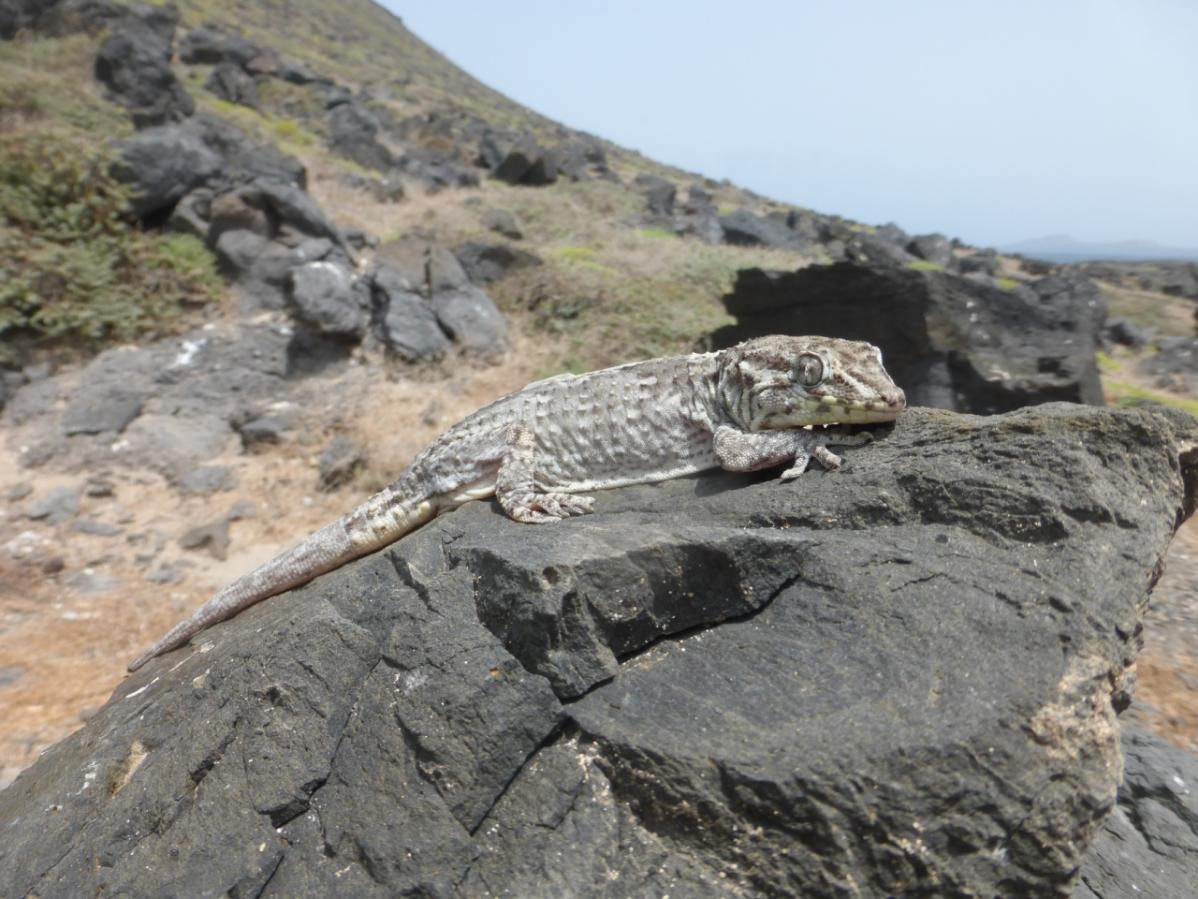Raquel Vasconcelos approved a new project to work in Cabo Verde
News

Photo legend: Tarentola gigas, an endemic Cabo Verde wall gecko to be studied in this project (photo by R. Vasconcelos).
Tropibio Researcher Raquel Vasconcelos approved a new project to work in Cabo Verde, the project is entitled "Big and small – How do we fit all? An integrative framework for investigating character displacement” (BIGFIT) and is funded by FCT EXPL/BIA-EVL/0470/2021).
The team members of the project are: Raquel Vasconcelos (CIBIO-BIOPOLIS), Brent Emerson (IPNA), Fernando Sequeira (CIBIO-BIOPOLIS), Maria Romeiras (ISA-UL), Evandro P. Lopes (UTA), PhD student Catarina J. Pinho (CIBIO-BIOPOLIS) and an UTA student (to be determined).
Project abstract:
Understanding the entangled network of interactions in natural communities and how species evolve in response to factors such as competition for resources are fundamental biological questions with implications for the conservation of endemic biodiversity. Although often referred to in the literature, cases providing strong support for character displacement (CD)– the evolutionary process whereby two resource competitors diverge in phenotype and resource use facilitating coexistence–are restricted (e.g. Darwin’s finches). Oceanic archipelagos represent ideal study models for character displacement (CD), compared to the mainland. First, they have a lower number of species, generally in higher densities and inhabiting confined areas and simplified ecosystems. Second, different islands provide replicas of analogous interaction patterns between sympatric species. Finally, low gene flow among islands promotes differentiation of peculiar characteristics more prone to extinction. Cabo Verde (CV) is an arid oceanic archipelago, situated 500km off the African Atlantic coast. It comprises ten islands and several islets, with ages between 2–6 million years (My) and holds 31 endemic terrestrial reptile taxa from 3 genera: Tarentola and Hemidactylus geckos and Chioninia skinks. Most are threatened, yet poorly studied, especially ecologically. Tarentola geckos reached CV 7.7My ago in a single colonization event from the Canary Islands, giving rise to 12 endemic species. The seven endemic Chioninia skinks also originate from a single colonization event from Africa 26My ago. Both groups derive from a medium-sized ancestral species, from which some developed larger body size in situ (T. gigas, C. vaillanti), while others maintained the ancestral size (C. delalandii) or became smaller (T. raziana). A few developed extreme body-sizes, such as the extinct C. coctei and for some, an increased rate in the evolution of this trait was proven. Suggestions of a character displacement (CD) hypothesis have been mentioned for both genera, but never explored in detail or using an integrative framework. Cabo Verde, is one of the few places where it is possible to study sister species with divergent sizes (i)inhabiting the same islands, (ii)using the same scarce food resources, and (iii)occupying the same (micro)habitat. As related species often present similar feeding and distribution habits, it creates a potential for competition. Syntopic reptile species have been found to rapidly diverge in ecological niches by shifting ranges, altering morphology or diet preferences to cope with competitors. Cabo Verde has been studied by this team for more than 12 years, presents an excellent framework to further explore species differentiation by testing for CD. The use of non-invasive genomic methods, together with traditional ecological approaches offers an innovative and solid framework, never used to tackle this question, to be broadly applied to test for CD. DNA-metabarcoding maximizes resolution, and detection of soft, small, rare and otherwise invisible diet items. It can also correct biases in ecological and morphological models and is less reliant on taxonomic expertise. Thus, it more rapidly and with more detail characterizes the diet of species with conservation needs, as is the case for most Cabo Verde reptiles.

Photo legend: Tarentola gigas, an endemic Cabo Verde wall gecko to be studied in this project (photo by R. Vasconcelos).
Project objectives:
This project aims to investigate dietary and niche preferences within three sympatric reptile species pairs to test if CD is driving speciation and subsequent morphological and ecological adaptations. Through an interplay between ecological, morphological and genomic data we intend to:
1) Quantify trophic interactions of target species pairs, identifying the main items consumed using DNA-metabarcoding with High throughput Sequencing (HTS), including new taxa for CV or for science;
2) Compare significant interspecific size and shape differences of species pairs in sympatry and allopatry using geometric morphometrics;
3) Infer the ecological niche overlap between species pairs using species distribution models;
4) Provide valuable data to guide conservation actions;
5) Promote capacity-building;
6) Additionally, we expect it to promote capacity-building, by strengthen the networking of InBIO’s TwinLab with local universities, and to benefit local conservation policy regarding the fragile insular taxa.
Initial Results and publications:
Santos B, Pinho CJ, Šťáhlavský F, Mata VA, Lopes RJ, Vasconcelos R (2022). Diet study of geckos reveals the first records of pseudoscorpions on Desertas Islands (Cabo Verde). Journal of Arachnology, 50: 39–42.